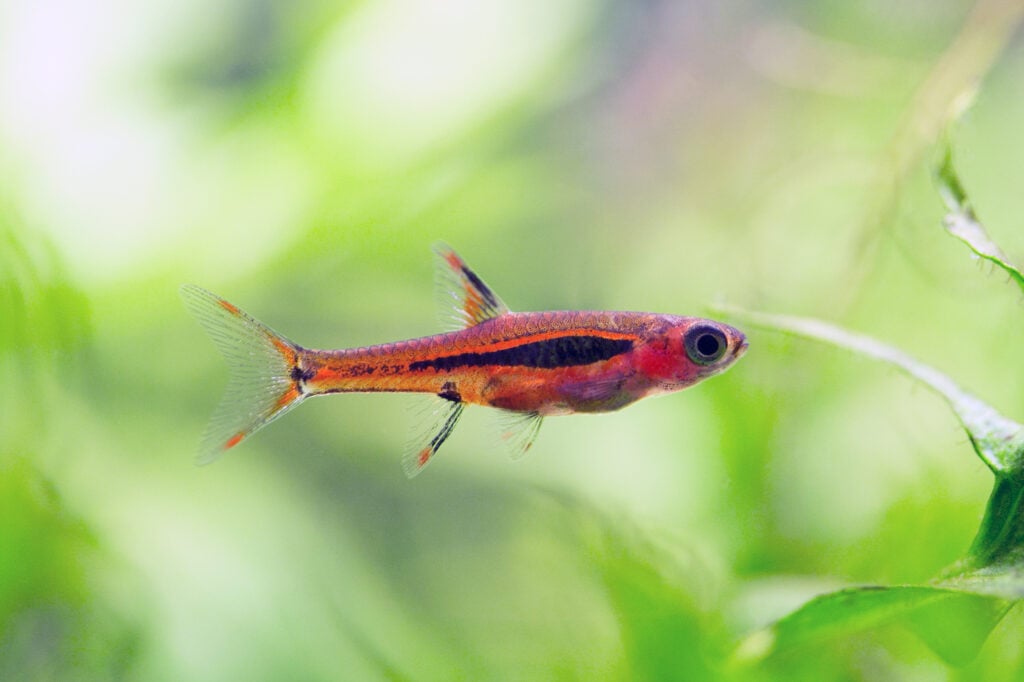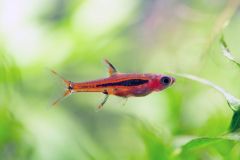Chili Rasbora Care: Diet, Size, Tank Size & Temperature

Table of Contents
Chili Rasboras Facts
Chili Rasboras also known as mosquito rasbora are a small freshwater fish. They have an elongated body with small black spots and orange-red stripes running along their sides. They typically reach an adult size of about 1 inch in length, making them ideal for smaller tanks. They are a schooling fish that falls into the nano fish category based on their small size. Most consider chili rasboras hardy fish ideal for any level of fish keeper.
Species Summary - Natural habitat
The Chili Rasbora boraras brigittae is a peaceful and sociable tiny fish that prefers to live in schools of at least six individuals. These nano fish are generally considered easy to care for and can be kept as long term residents in aquariums of the correct size and temperature range. Chili rasboras live in slow-moving streams and lakes in southeastern Asia. They prefer water that is slightly acidic with soft, sandy substrate and plenty of hiding places like logs, rocks, and plants. In the wild, Chili rasboras are omnivorous, feeding mainly on small insect larvae, worms, crustaceans, and plankton. In the aquarium trade, they can be fed a variety of frozen or live foods such as baby brine shrimp, bloodworms, Daphnia, or specially formulated fish flakes.
Chili rasbora behavior
Chili rasbora boraras brigittae are a relatively active schooling fish. They will be found free swimming around the tank in search of food, and can become territorial if kept with other similar sized species. It is best to provide them with plenty of hiding places so they can feel secure. Floating plants like red root floaters, frogbit, or duckweed provide are ideal.
Best Chili Rasbora Care and Tank Conditions
When kept in an aquarium, Chili rasboras can live in a nano tank of 5 gallons, however a tank of at least 10 gallons is ideal. The water should be maintained between 72 to 79 degrees Fahrenheit and slightly acidic, with a pH of 6-7.5. A low flow filter is recommended to keep the water clean and stable. Sand or small gravel substrate should be used for these fish, and they will appreciate some live or artificial plants for hiding. Being one of the smallest tropical fish they appreciate hiding places when they sense danger.
Mosquito rasboras aka chili rasboras will show their black and red line best on dark substrate in a planted aquarium. This is due to the fact they will feel safest in a beautiful planted aquarium setups which are on the more densely planted side. These fish tend to seek out cover when they feel stressed.
Chili rasboras are peaceful and do best when kept in schools of at least 6-8 individuals. Other small, peaceful nano fish of similar size can also be added to the tank, such as dwarf Corydoras catfish, danios, small tetras, or adult shrimp! Bare in mind baby shrimp may get eaten as they are natural food for chili rasboras at the small size.
Chili rasboras are omnivorous, and their diet should include a variety of both plant-based foods such as algae wafers, spirulina flakes, and frozen brine shrimp as well as insect larvae and other small invertebrates. Live foods can be offered to chili rasbora occasionally as well.
Water Parameters
Chili rasboras (boraras brigittae) prefer a water temperature of 72-82°F (22–28°C) and an acidic water to neutral pH of 6.0–7.5. To maintain the right levels, regular partial water changes should be done on a weekly basis with treated tap water that is similar in temperature to the tank water.
Food & Diet Recommendations
Chili rasbora/mosquito rasbora are omnivorous and have a varied diet. They should be fed high-quality flakes or pellets designed for small fish, as well as occasional live foods such as brine shrimp, micro worms, daphnia, mosquito larvae, and bloodworms. Vegetarian options such as algae wafers and spirulina flakes are also good options. Feed Chili rasbora 2-3 times daily in small amounts that can be consumed in a few minutes.
Chili Rasboras Breeding
Chili rasboras are egg-scatterers, meaning that they scatter their eggs randomly and do not form pairs or care for their young. The adult chili rasbora will eat the eggs if given the chance, so it is best to separate them before spawning begins. Keeping the eggs in a separate breeding tank is ideal so it is easy to move the adult fish out after spawning. Spawning can be triggered by raising the water temperature slowly to around 82. Chili rasboras are known to spawn in small groups, with the males displaying their bright red coloration as they chase the female. However, breeding them in captivity can be difficult due to water parameters and other environmental factors. To encourage successful breeding, feed them a varied diet high in protein and provide plenty of hiding places for them to feel secure. The water should also be slightly acidic with a temperature of 76-82°F induce them to breed more easily.
What To Include In The Tank
Chili rasboras (boraras brigittae) need plenty of swimming space and prefer a tank with lots of vegetation. The water should also be well-oxygenated, so use an air pump or filter to ensure adequate flow throughout the tank. Add a few hiding places for the Chili rasbora to feel secure such as Java moss, driftwood, plants, and caves. Floating plants as meantioned above are also ideal. A sandy substrate is best for these fish since they like to sift through the sand in search of food.
Diseases To Watch Out For
Chili rasboras are quite hardy and disease-resistant but they may still become afflicted with common fish illnesses like ich, velvet, or bacterial infections. If you notice any strange behavior or changes in the appearance of your Chili rasbora, be sure to quarantine them immediately and treat the tank accordingly.
Columnaris
Columnaris presents as mold-like lesions on the fish. Bad water quality and poor diet are among the causes of columnaris. The disease is highly contagious. The spread of this disease from one fish to another in the tank is common. There are medications available for treatment. A deep clean of your aquarium is needed to prevent re-infection.
Fin Rot
Fin rot is usually caused by poor water quality and ammonia poisoning. The fins of the fish will start to disintegrate and the gills will become inflamed. The infection can spread rapidly, so it's important to act quickly when signs are observed. Treatment includes partial water changes and adjusting the pH levels of the tank. Antibiotics may also be required to get rid of the infection.
Ich
Ich is a parasite that can infect chili rasboras, leading to white spots on the body and fins. Treatment usually involves elevating the temperature of the tank to 85°F – 87°F and adding aquarium salt. Copper treatments may also be necessary in order to eradicate the parasites from the tank.
Nitrite poisoning
Nitrite poisoning is a common problem for chili rasboras, as they are very sensitive to high nitrate levels. Symptoms include clamped fins, rapid gill movement, and darkening of the skin. If nitrite poisoning is suspected, it's important to do regular water tests and perform partial water changes in order to reduce the nitrite levels in the tank.
Velvet
Velvet disease is another common ailment that can affect chili rasboras. This parasitic infection causes the fish to develop golden patches on their skin and often leads to loss of appetite and lethargy. Treatment involves using special medications, such as copper sulphate or formalin, to kill off the parasites. It's important to regularly monitor the tank for signs of velvet and to act quickly if it is detected.
Chili Rasboras are hardy fish, but they can still fall ill if not taken care of properly. To keep them healthy and thriving, be sure to provide a diet high in protein and maintain optimal water conditions. Quarantine any new live plants or livestock before adding to your aquarium to help prevent the addition of any illness.
Chili rasbora tank mates
Chili rasboras are very peaceful fish should be kept with other peaceful and similarly sized fish in a community tank Good tank mates for Chili rasboras include tetras like neon tetra, guppies, platies, Corydoras catfish, dwarf shrimp like amano shrimp, or other dwarf shrimp like cherry shrimp! Avoid keeping them with larger or aggressive fish such as cichlids that may prey on the smaller Chili rasbora.
Water source
Although the treatment and preservation of chili-rasbora are relatively simple, the use of tapwater does not mean the aquarium is the main source of the water. Tap water has numerous unknowns and can pose numerous issues to your tanks. It is quite difficult to make tap water phosphate-rich as there are many. Too many phosphorus are present in sand and water in aquariums. Although plants require phosphate for living, algae may take up the phosphate before the plants could, creating more algae and more decomposers which produce more phosphorus.
Other Types of Rasboras
Other peaceful nano fish of the rasbora family include neon green rasboras, crystal red rasboras, and harlequin rasboras. The neon green rasbora is a bright emerald green with an orange-red sheen on its head, while the crystal red has bright reddish markings (similar to the Chili Rasbora's markings). The harlequin rasbora is black and white with yellowish fins.
Frequently Asked Questions
Yes, Chili Rasboras are a great choice for beginners. They are peaceful, easy to care for, and do not require a large tank size. With the right water conditions and diet they will thrive!
Chili Rasboras do well in a 10-gallon aquarium or larger. They prefer tanks with plenty of hiding spots and planted areas for them to explore and swim around. The water should be kept clean and well-oxygenated, so an external filter is recommended.
Chili Rasboras are omnivores, so they should be fed a variety of both meaty and plant-based foods. Some good choices include live or frozen foods such as brine shrimp, bloodworms, and daphnia. Plant-based foods like spirulina flakes or blanched vegetables are also suitable.
Chili Rasboras prefer a water temperature between 74-80 degrees Fahrenheit (23-27 degrees Celsius). It is important to keep the water temperature steady and consistent in order to maintain good health.
Chili Rasboras are a small fish that only reach about 1-1.25 inches in length when fully grown. They have an elongated body with red markings on their fins and head.
Conclusion
The Chili Rasbora is a small, peaceful fish that makes a great addition to any aquarium. These fish require clean, well-maintained water with a neutral pH and temperature between 72°F and 82°F. They are omnivores that primarily feed on live or frozen food, such as bloodworms, glass worms, or brine shrimp. They need plenty of swimming space, so a tank size of at least 10 gallons is recommended for them. Lastly, they do best in an aquarium with plenty of plants for cover and food sources. With the right care and diet, these fish can make beautiful additions to any freshwater tank!
Buy Chili Rasboras For Sale Online Here


 Shrimp
Shrimp Fish
Fish Crab &
Crab & Plants
Plants Foods
Foods Snails
Snails